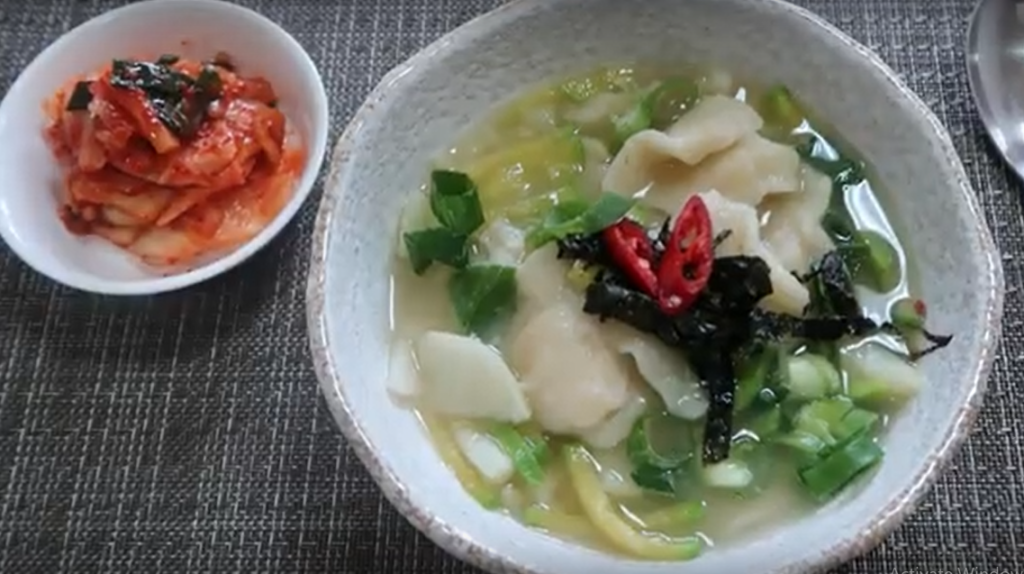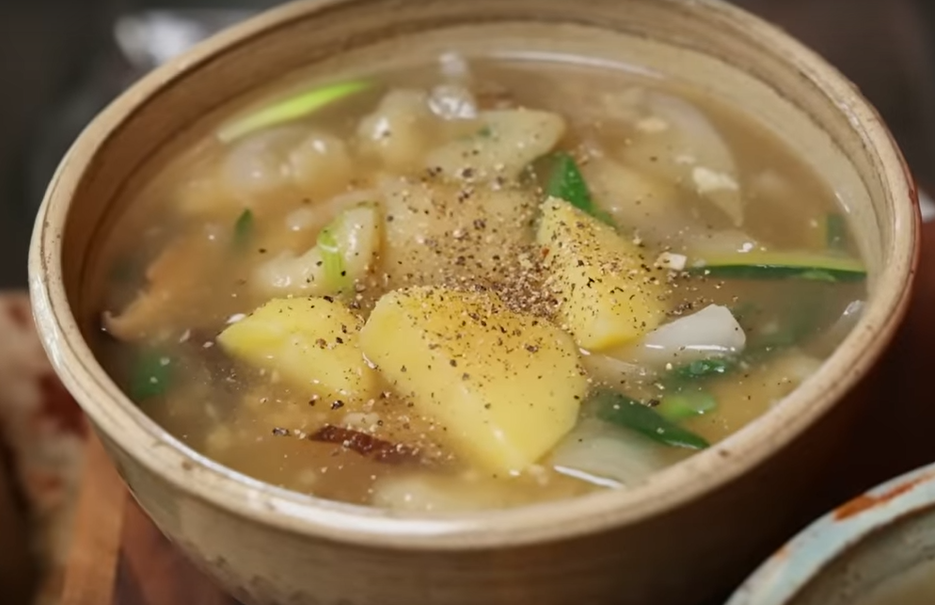In Korean cuisine, a beloved dish has captured many’s hearts and taste buds – Sujebi. This delectable comfort food combines the simplicity of handmade dough with a flavorful broth, resulting in a soul-soothing delight. In this article, we will delve into the world of Sujebi, exploring its history, ingredients, preparation, and variations. So, let’s roll up our sleeves and embark on a culinary journey to master the art of Sujebi!
Table of Contents
The Origins of Sujebi
Sujebi, also known as “hand-pulled dough soup,” has a rich history dating back to ancient Korea. This hearty dish was born from the necessity of making the most of simple ingredients. Initially, it was considered peasant food, but over the years, it has gained popularity across all social strata for its comforting flavours.

Overview of Sujebi Recipe
Gathering the Ingredients
Before we jump into the cooking process, let’s gather the essential ingredients for Sujeebi:
– All-purpose flour
– Water
– Salt
– Soy sauce
– Vegetables (commonly zucchini, potato, and onion)
– Protein (chicken, beef, or seafood)
– Seasonings (garlic, ginger, and sesame oil)
Crafting the Dough
The heart of Sujebi lies in its dough. To create the perfect dough , follow these steps:
1. Mix the all-purpose flour and water together in a mixing bowl. Mix the all-purpose flour and water together in a mixing bowl.
2. Mix the ingredients so they are well combined and Smoothness and elasticity are achieved in the dough.
3. Roll out the dough and cut it into irregular pieces. These irregular shapes are what give unique texture.
Preparing the Broth
While the dough rests, let’s prepare the flavorful broth:
1. To begin, heat up a large pot of water until it comes to a boil.
2. Add soy sauce, garlic, ginger, and salt to the boiling water.
3. Allow the broth to simmer, infusing it with aromatic flavors.
Bringing It All Together
Now, it’s time to bring the dough and broth together to create the mouthwatering Sujabi:
1. Gently drop the dough pieces into the simmering broth.
2. Add your choice of protein and vegetables.
3. Let the ingredients cook until the dough is tender and the protein is fully cooked.
4. Season with sesame oil and additional salt to taste.
Variations of Sujebi
It is a versatile dish with countless regional variations. Some popular ones include:
– Haemul Sujebi (Seafood-Sujebi)
– Kimchi Sujebi (Kimchi-based Sujebi)
– Dangmyeon Sujebi (Sweet Potato Noodle-Sujebi)
Serving and Enjoying
To serve, ladle the hot soup into bowls and garnish with green onions or toasted seaweed. It’s best enjoyed piping hot, especially on a chilly day. Combining chewy dough, flavorful broth, and fresh ingredients will surely delight your taste buds.
Sujebi, a beloved Korean dish, offers a delightful blend of flavors and textures. In this article, we will delve into the art of making, exploring its ingredients and nutritional aspects. So, let’s embark on this culinary journey together and discover the secrets of a delicious and healthy meal.
What is Sujebi?
Sujebi, often called “hand-pulled dough soup,” is a traditional Korean dish with a rich history. It’s a versatile and comforting meal made from a simple yet hearty dough-based soup. This dish is cherished not only for its taste but also for its nutritional value.
Sujebi Recipe: Step by Step Guide
Ingredients
Before we start cooking, let’s gather the critical ingredients needed to prepare this delectable Korean delicacy:
For the Dough:
1. All-Purpose Flour: You’ll need 2 cups of all-purpose flour to make the dough.
2. Water: Approximately 1 cup of water is required for the correct dough consistency.
3. Salt: A pinch of salt enhances the flavor of the dough.

For the Soup Base:
1. Chicken or Vegetable Broth: 4-5 cups of broth serve as the base of your soup.
2. Potatoes: 2 medium-sized potatoes, peeled and diced.
3. Zucchini: 1 zucchini, thinly sliced.
4. Carrots: 2 carrots, finely chopped.
5. Onion: 1 onion, chopped.
6. Minced Garlic: 2 cloves of minced garlic.
7. Soy Sauce: 2 tablespoons of soy sauce for seasoning.
8. Sesame Oil: A drizzle of sesame oil adds a delightful aroma.
9. Salt and Pepper: Season to taste.
Nutrition Strategy
Before jump to recipe , lets know some nutrition strategy:
Sujebi isn’t just a treat for your taste buds; it’s also a healthy meal option. Let’s explore the nutritional strategy behind this dish:
Balanced Nutrients:
It provides a balanced combination of carbohydrates from the dough, protein from the broth, and various vitamins and minerals from the vegetables.
Low in Calories:
With proper portion control, It can be a part of a low-calorie diet plan, making it suitable for those aiming to maintain or lose weight.
Rich in Fiber:
Including vegetables ensures a good dose of dietary fiber, promoting digestive health and aiding in weight management.
Heart-Healthy:
Using chicken or vegetable broth as the soup base makes heart-healthy by reducing saturated fat content.
Cooking Process
Now that we have our ingredients and nutritional strategy in place let’s dive into the cooking process step by step:
Making the Dough:
1. combine the all-purpose flour, a pinch of salt, and water in a bowl. The contents should be worked into a smooth dough.
2. On a surface that has been lightly floured, roll out the dough and cut it into random pieces. These dough pieces give its unique texture.
Preparing the Soup:
1. bring the chicken or vegetable broth to a boil in a large pot.
2. Add the diced potatoes, sliced zucchini, chopped carrots, onion, and minced garlic to the boiling broth.
3. Let the vegetables simmer until they become tender.
4. Carefully drop the dough pieces into the simmering soup. Stir gently to prevent sticking.
5. Season with soy sauce, sesame oil, salt, and pepper to taste.
6. Allow the soup to cook for 5-10 minutes until the dough is fully cooked and the flavors are well combined.
The Best Sujebi Restaurants Near USA (Sujebi Near Me)
1. Seoul Garden – Los Angeles, California
Located in the heart of Los Angeles, Seoul Garden is a haven for Sujabi enthusiasts. Their Sujabi is renowned for its delicate dough and rich broth. Whether you’re a Sujebi fan or trying it for the first time, Seoul Garden is a must-visit.
2. Kimchi House – New York City, New York
If you’re in the Big Apple and craving Sujebi, head over to Kimchi House. This cozy restaurant offers a variety of Korean dishes, but their Sujebis is a standout. The dumplings are made to perfection, and the broth is flavorful.
3. Jinjuu – Washington, D.C.
For a modern twist on traditional Sujebii, Jinjuu in Washington, D.C., is the place to be. They infuse creativity into this classic dish while maintaining its authentic essence. Jinjuu’s Sujebi is a delightful blend of tradition and innovation.
4. Nuri Sujebi – Chicago, Illinois
In the Windy City, Nuri Sujebi stands out as a go-to spot for lovers. Their handmade dumplings and savory broth will leave you craving for more. It’s a warm and inviting place to enjoy this Korean comfort food.

5. K-Town Food Court – Annandale, Virginia
Last but not least, the K-Town Food Court in Annandale, Virginia, offers a variety of Korean culinary delights, including outstanding Sujeebi. This food court is a favorite among locals and visitors alike for its authenticity and diverse menu.
If you want to taste the true essence of Korean comfort food, then Sujeebi is the perfect dish for you. It promises a comforting and satisfying meal that’s worth mastering. So, roll up your sleeves and prepare your ingredients for an amazing cooking experience. From the lively streets of Los Angeles to the vibrant neighborhoods of New York City, these restaurants will take your taste buds on an unforgettable journey through Korea’s culinary delights. Don’t hesitate any longer – start your adventure today!
Frequently Asked Questions (FAQs)
1. What is the origin of Sujeebi?
It has its roots in Korean cuisine and has been enjoyed for generations.
2. Can I use whole wheat flour for the dough?
You can alternate all-purpose flour with whole wheat flour for a healthier twist.
3. Is Suujebi suitable for vegetarians?
Absolutely! For a wonderful vegetarian alternative, omit the chicken and substitute veggie broth.
4. What more veggies can I put to Suujebi?
For added variety, feel free to experiment with vegetables like spinach, mushrooms, or green beans.
5. Can I make a spicy version ?
Certainly! If you want spicy food, sprinkle some red pepper flakes or gochugaru on top.





